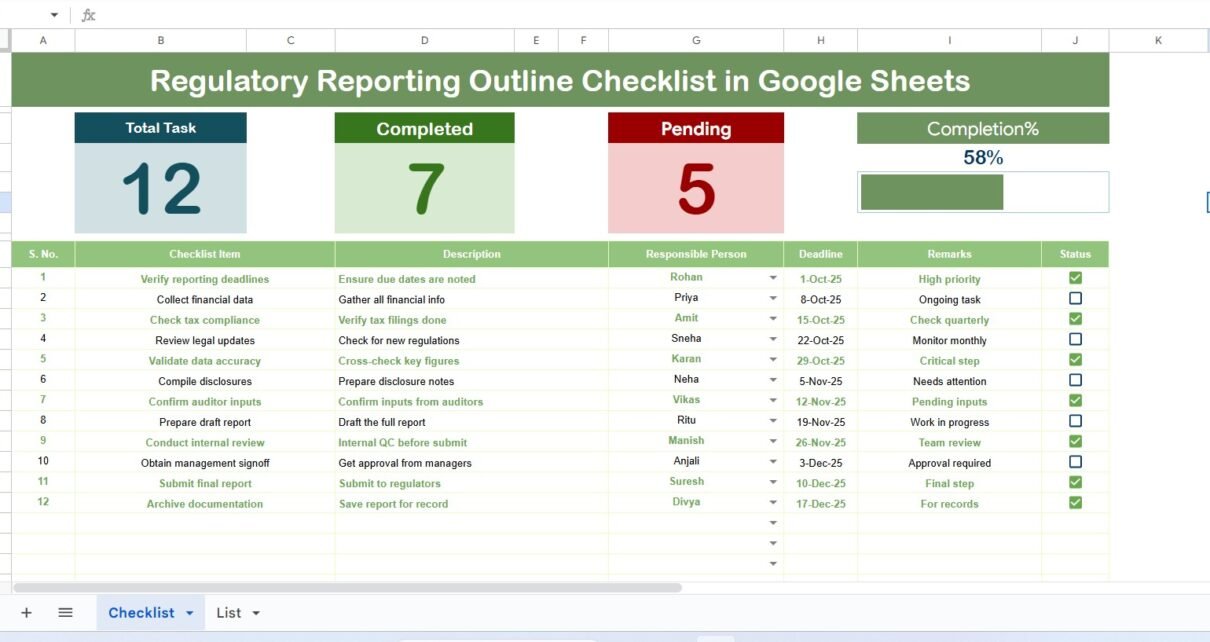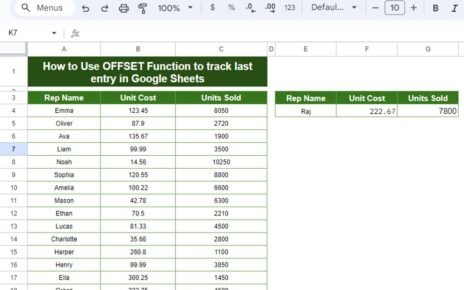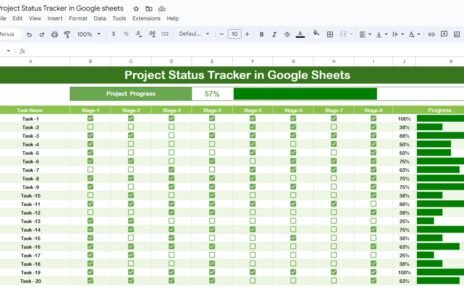Regulatory reporting is one of the most important responsibilities for businesses in every industry. Organizations need to meet strict compliance standards, follow legal frameworks, and ensure timely submissions of reports to regulators. Missing deadlines or leaving errors in reporting can lead to penalties, reputational damage, and even loss of business licenses.
To address this challenge, many professionals rely on checklists. A Regulatory Reporting Outline Checklist in Google Sheets provides a simple, flexible, and powerful way to manage reporting tasks. With it, businesses can streamline compliance workflows, assign responsibilities, track progress, and stay audit-ready.
In this article, we will explore the structure, features, benefits, best practices, and real-world applications of a Regulatory Reporting Outline Checklist in Google Sheets.
Click to Purchases Regulatory Reporting Outline Checklist in Google Sheets
What Is a Regulatory Reporting Outline Checklist?
A Regulatory Reporting Outline Checklist is a structured tool that helps businesses prepare, track, and monitor all reporting requirements. It acts as a central guide to ensure no critical step gets overlooked.
Instead of manually managing deadlines and tasks across different files, this checklist brings everything into one digital platform—Google Sheets. Because it is cloud-based, team members can collaborate in real-time, update progress instantly, and work from anywhere.
Why Use Google Sheets for Regulatory Reporting?
Google Sheets is one of the most versatile platforms for checklist management. It eliminates the need for expensive compliance management systems while still offering dynamic features like:
-
Real-time collaboration – Multiple users can work on the same checklist at once.
-
Accessibility – Open the file from desktop, mobile, or tablet without special software.
-
Automation support – Add formulas, conditional formatting, and even App Script automation.
-
Data validation – Use dropdowns and structured inputs to maintain consistency.
-
Cloud security – Changes are auto-saved and version history is available.
By building the checklist in Google Sheets, businesses gain flexibility without compromising accuracy.
Structure of the Regulatory Reporting Outline Checklist in Google Sheets
The template is divided into two worksheets:
1. Main Checklist Sheet
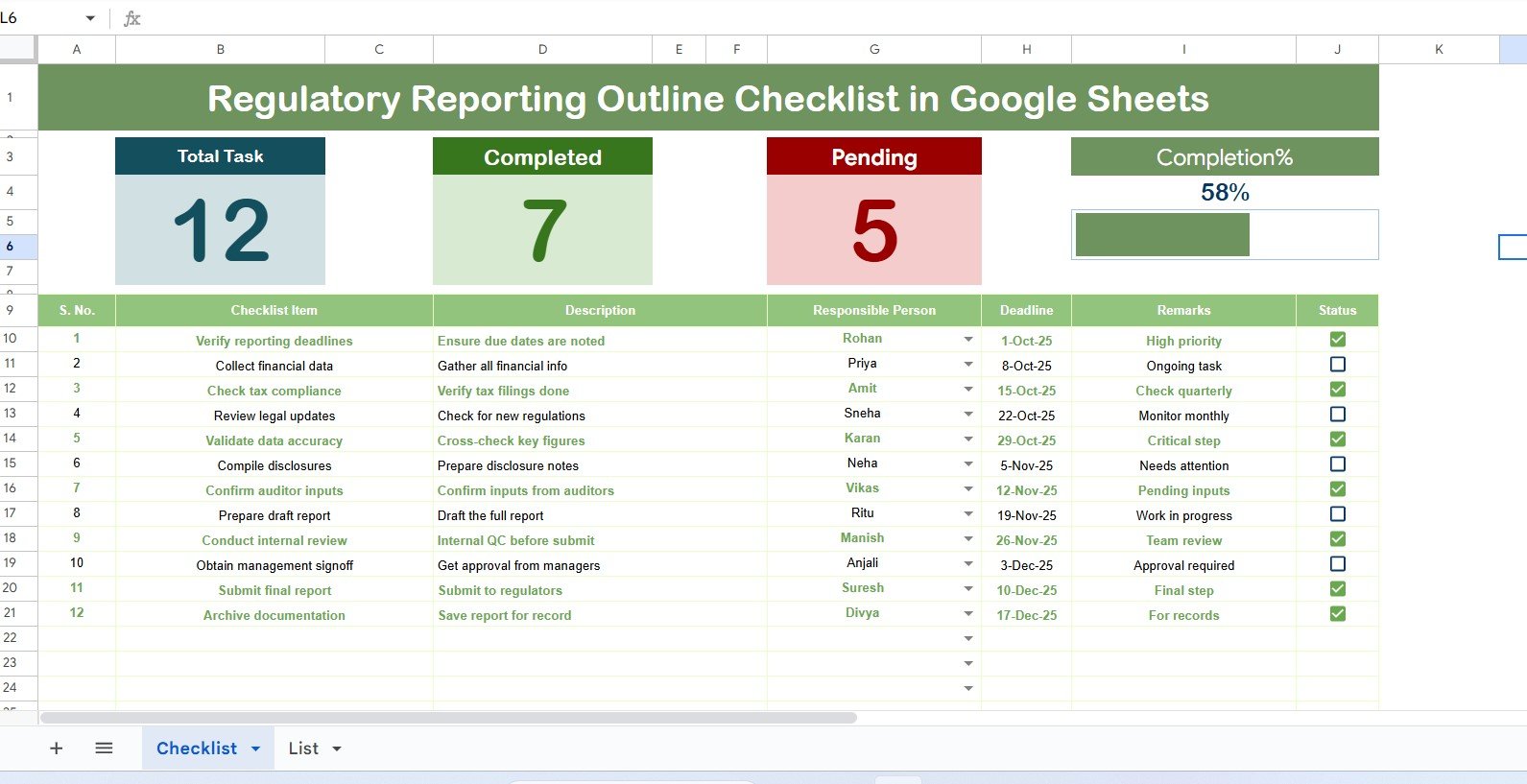
This is the core section where compliance tasks are tracked.
Top Section
-
Displays 3 important cards:
-
Total Count – Total number of checklist items.
-
Completed Count – Number of items already marked ✔.
-
Pending Count – Number of items left ✘.
-
-
A progress bar shows the overall completion percentage.
Checklist Table
The heart of the template includes the following columns:
-
Serial No. – Unique task identifier.
-
Checklist Item – The reporting requirement or task.
-
Description – Short details about the item.
-
Responsible Person – Assigned staff member.
-
Deadline – Due date for the report or task.
-
Remarks – Notes, clarifications, or instructions.
-
Status – Marked ✔ or ✘ to track completion.
This clear layout ensures every regulatory task is visible and measurable.
2. List Sheet Tab
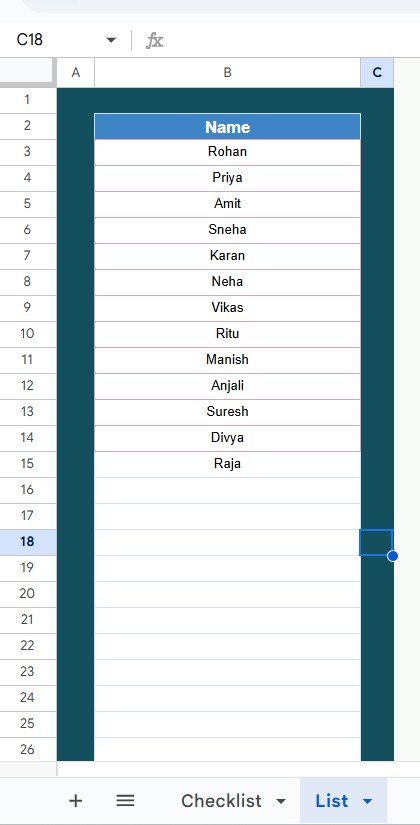
The second sheet is a supportive table where all Responsible Persons are recorded.
-
This list automatically feeds into the drop-down menu in the main sheet.
-
It reduces errors in manual entry and maintains standard naming conventions.
-
It also helps managers quickly identify who is responsible for each reporting task.
Advantages of Using a Regulatory Reporting Outline Checklist
A checklist may seem like a simple tool, but it provides huge benefits for compliance management:
- ✅ Improved Accuracy
- Every reporting requirement is recorded, leaving no room for missing steps.
- ✅ Accountability
- Each task is assigned to a responsible person, ensuring clear ownership.
- ✅ Time Management
- Deadlines are visible, helping teams prioritize urgent reporting tasks.
- ✅ Progress Tracking
- The progress bar and completion count provide instant status updates.
- ✅ Collaboration
- Since the template is in Google Sheets, multiple users can update it in real-time.
- ✅ Cost Efficiency
- It avoids the need for costly compliance management software.
- ✅ Audit Readiness
- Well-maintained checklists act as documentation proof during inspections.
Key Features of the Google Sheets Template
Here’s what makes this checklist template powerful and practical:
-
📊 Dashboard Cards – Quick snapshot of total, completed, and pending tasks.
-
✅ Status Column – Simple ✔ or ✘ markers for clarity.
-
📝 Customizable Fields – Add or remove columns as per organization needs.
-
👩💼 Drop-Down Responsible Person – Ensures consistent task assignment.
-
📅 Deadline Tracking – Helps avoid delays in submissions.
-
🎨 Conditional Formatting – Color codes pending vs completed tasks.
-
☁️ Cloud Storage – Accessible from anywhere, anytime.
How to Use the Regulatory Reporting Outline Checklist
Step 1: Set Up the Template
Open the template in Google Sheets. Add all reporting requirements into the Checklist Item column.
Step 2: Assign Responsibility
Choose the Responsible Person from the drop-down menu.
Step 3: Define Deadlines
Enter the due dates for each report to align with regulatory schedules.
Step 4: Track Status
As tasks are completed, mark ✔ in the Status column. Pending items stay ✘ until finished.
Step 5: Monitor Progress
Use the cards and progress bar to check completion percentage and pending workload.
Best Practices for the Regulatory Reporting Outline Checklist
Following best practices ensures the checklist remains effective over time:
🔹 Update Regularly – Add new regulations and remove outdated ones.
🔹 Use Clear Descriptions – Keep task explanations short but precise.
🔹 Assign Backup Persons – Ensure continuity in case the main responsible person is unavailable.
🔹 Review Deadlines Monthly – Align with changing reporting calendars.
🔹 Leverage Conditional Formatting – Highlight overdue tasks in red for quick attention.
🔹 Maintain Version Control – Keep a log of updates for audit trails.
🔹 Automate Notifications – Use Google Workspace tools to send deadline reminders.
Opportunities for Improvement
Even though the template is effective, organizations can take it further:
-
Integrating Google App Script for automated reminders.
-
Linking the checklist with Google Calendar to schedule deadlines.
-
Creating pivot tables for advanced analysis of reporting efficiency.
-
Adding chart visuals to track completion by department or person.
-
Combining with compliance documentation repositories for direct access.
Real-World Applications of the Checklist
This template can be applied across multiple industries and functions:
-
Financial Services – Tracking quarterly regulatory filings.
-
Healthcare – Ensuring compliance with patient data privacy laws.
-
Manufacturing – Monitoring safety certifications and inspections.
-
Education – Handling annual institutional accreditation reports.
-
Technology – Meeting cybersecurity compliance frameworks.
Conclusion
A Regulatory Reporting Outline Checklist in Google Sheets is more than just a list—it is a compliance management tool. With its structured format, accountability features, and progress tracking, it helps businesses stay compliant, avoid penalties, and streamline their reporting process.
By adopting this template, organizations can save time, reduce errors, and foster accountability across teams. Whether you are a small business or a large corporation, this checklist offers a practical, cost-effective solution to complex regulatory requirements.
Click to Purchases Regulatory Reporting Outline Checklist in Google Sheets
Frequently Asked Questions (FAQs)
1. What is the purpose of a Regulatory Reporting Outline Checklist?
It ensures all regulatory reporting tasks are documented, assigned, and completed on time.
2. Why should I use Google Sheets instead of Excel?
Google Sheets allows real-time collaboration, cloud storage, and easier sharing, making it ideal for teams.
3. Can I customize the checklist for my industry?
Yes. You can add or remove columns, modify checklist items, and adapt it to your organization’s needs.
4. How does the progress bar work?
The progress bar automatically updates based on the number of completed vs pending items.
5. Is this checklist useful for audits?
Yes. It provides documentation of completed tasks and shows accountability, which is valuable during audits.
6. Can I integrate this checklist with reminders?
Yes. By using Google App Script or connecting with Google Calendar, you can set up automated alerts.
7. How often should I update the checklist?
It should be updated whenever new reporting requirements are introduced or deadlines change.
Visit our YouTube channel to learn step-by-step video tutorials
Youtube.com/@NeotechNavigators
Click to Purchases Regulatory Reporting Outline Checklist in Google Sheets
